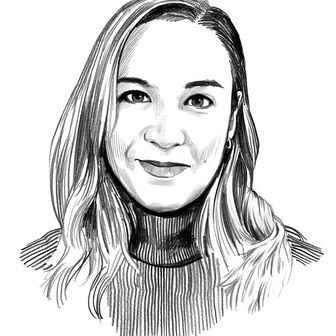
President Trump’s Medicare for All op-ed, published on Wednesday in USA Today, builds its case on a foundation of lies. Some are familiar falsehoods: Medicare for All would take health care from seniors, lead to health-care rationing, and generally inflict pain on the innocent. “Every single citizen will be harmed by such a radical shift in American culture and life,” Trump warned.
Republicans are masters of fire-and-brimstone rhetoric, especially on the issue of healthcare, but fear-mongering can’t alter fact. As Vox noted later on Wednesday, Democrats haven’t actually proposed a plan that would take Medicare away from seniors, and Trump’s other apocalyptic warnings are shaped by the omission of relevant facts. If private health insurance really improved health-care outcomes in ways that public systems did not, then the introduction of single-payer would indeed be a bad idea. Similarly, if private health insurance plans actually met patients’ needs and remained affordable, it would be much easier to believe that recent Democratic interest in Medicare for All is part of some nefarious, ideologically motivated plot, as Trump suggests.
But a new report, released by the Economic Policy Institute the same day Trump’s op-ed went live, undercuts many of the president’s arguments. Healthcare costs are rising, which drives up premiums for employer-sponsored, private insurance plans. That, in turn, helps keep incomes and wages low. Josh Bivens, EPI’s director of research, concluded that the total cost of a family insurance plan provided by a member’s employer more than tripled between 1999 and 2016, jumping from an average of $5,791 to $18,142. For families whose earning fell in the bottom 90 percent, total premium costs as a share of their earnings doubled over the same period, from 25.6 to 51.7 percent.
Rising costs don’t just burden families, either. For single people earning in the bottom 90 percent, premiums as a share of their average annual earnings jumped from 9.7 percent in 1999 to 18.3 percent in 2016. In the past two decades, the private insurance plans that Trump allegedly wants to preserve have gotten more expensive, and have become more burdensome for American workers.
These trends hit workers hardest, but they’re expensive for all parties involved. Bivens found that out-of-pocket costs for workers increased by 53.5 percent from 1999 to 2016, and costs paid by insurers increased by 48.5 percent over the same time period. In 2015, the United States spent 16.8 percent of its national GDP on health care; the United Kingdom, by contrast, spent 9.8 percent. Insurers pay more, so employers pay more, and they pass the burden down to workers, who can afford it the least.
EPI’s report isn’t the first time that researchers have blamed costs, as opposed to utilization of services, for inflating the U.S.’s overall health spending. A 2018 study published in the Journal of the American Medical Association found that Americans don’t use health care services at significantly higher rates, compared to 12 other developed nations. Rather, high salaries for doctors, high administrative costs, and high prescription drug costs all help explain why the U.S. spends such a disproportionate amount of money on health care.
“The narrative that has come up, that has developed, is that America spends so much more because Americans demand more health care. We have done, through the Affordable Care Act and other policy efforts, almost nothing about prices. To me, that has been the big missed opportunity,” one of the study’s co-authors, Ashish Jha of the Harvard T.H. Chan School of Public Health, told the Washington Post at the time.
The problem, in other words, doesn’t lie with patients. In fact, the utilization argument bears no small resemblance to arguments that tie poverty to individual or cultural failings. Health care isn’t expensive because Americans use too many services. Responsibility belongs elsewhere, with whoever sets the prices.
Americans don’t get their money’s worth, either. American health care isn’t particularly good in comparison to other industrialized nations. According to a 2015 report by the Commonwealth Fund, the U.S’s high health expenditures don’t correlate to longer, healthier lives for its residents. In fact, Americans experienced shorter lifespans and higher infant mortality rates than 12 other industrialized economies. High national expenditures obviously don’t promise good health outcomes for residents. And if costs continue to rise, without any regulatory intervention, workers and employers alike will continue to pay more for health insurance while experiencing no added benefit in return for their money. That’s not conducive to higher wages. It doesn’t seem like a coincidence, either, that individuals with employer-sponsored insurance still have problems paying their medical bills. A 2016 Kaiser Family Foundation study found that 19 percent of Americans who say they either have trouble with medical bills, or can’t pay their bills at all, have health insurance through an employer.
EPI’s Bivens suggests a series of cost-containment measures, including a public option and the implementation of all-payer rate setting, which would ensure that insurance providers all pay the same rates for medical services at a particular hospital. Other, more dramatic reforms, like Medicare for All, could also help rein in health-care costs. Public support for Medicare for All or some other form of single-payer health care has gathered momentum. A reasonable observer could absolutely infer that growing public favorability toward single-payer health care stems from lived experience, and not just from a certain independent senator’s upstart primary campaign.
The rising costs of employer-sponsored insurance aren’t just relevant to Medicare for All, or to the wage stagnation debate. They also undermine a pervasive myth.
The idea that work can, on its own, lift people out of poverty and off the welfare rolls regularly undergirds attacks on the welfare state. Bill Clinton’s welfare reforms imposed a 60-month time limit on benefits in most cases, in the name of getting the poor into the workforce. That intention shaped the very name of the bill, the Personal Responsibility and Work Opportunity Act. The Republican Party’s recent push to weigh down other entitlement programs by adding work requirements relies on this same premise. As of September, 11 states had taken advantage of a new waiver to set work rules for Medicaid, which would, if you believe the Trump White House, help Americans “rise out of poverty” and “attain independence.” Earlier this year, the U.S. House of Representatives passed a version of the farm bill that would impose stricter work requirements for SNAP beneficiaries, a provision that the House Agriculture Committee chairman, Republican Michael Conaway, called “a springboard out of poverty.” Get a job, and self-sufficiency manifests itself. America is already great.
But most Americans get health insurance through their employers. People are working — unemployment numbers are down, after all. Sloth isn’t the problem. If workers can’t consistently count on employers for either a living wage or affordable health insurance, the act of getting a job hardly guarantees economic security. Without the cushion of independent wealth, where can an American worker stand in safety? The floorboards are rotten, and you’ll fall right through them.






























